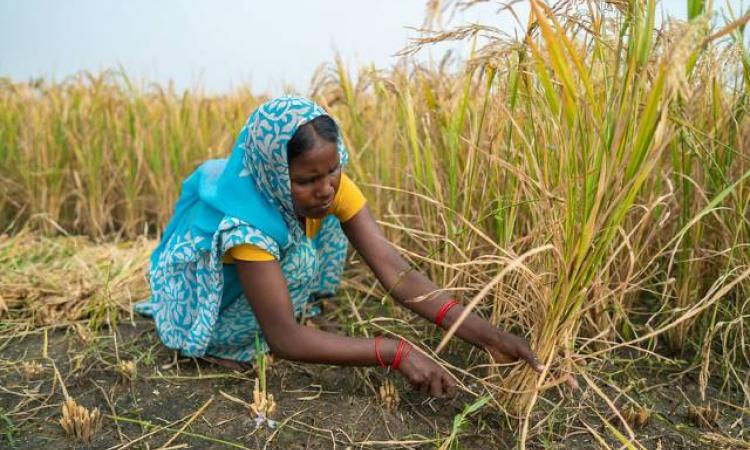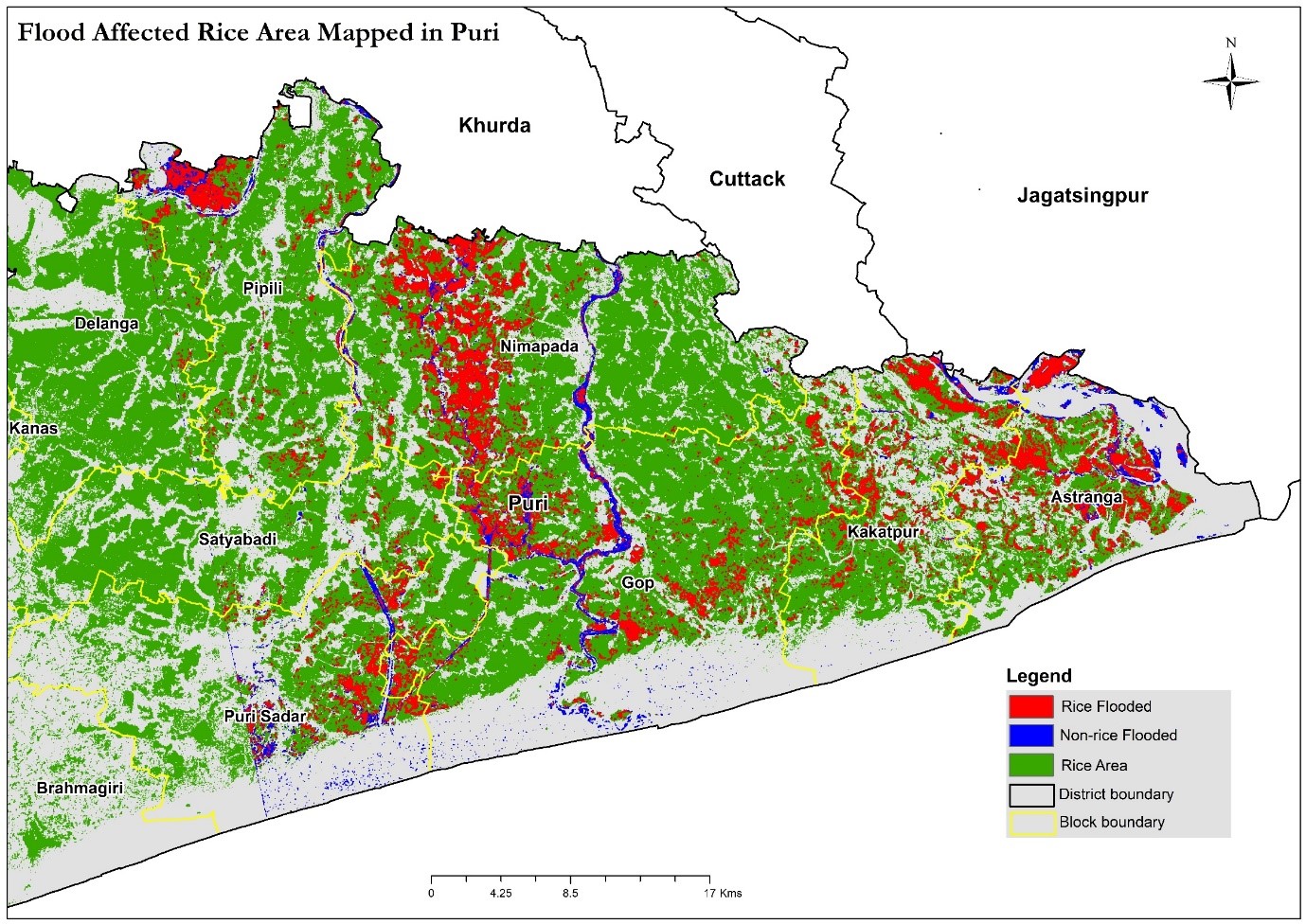
- Natural calamities, primarily floods, of varying intensity adversely affect the standing crop, leading to poor harvests. Such untoward climatic shocks invariably hit almost all blocks of Puri District in Odisha.
- The variety-based climate-smart intervention proved to be a potential response in the flood-prone rice areas.
- This can be replicated and scaled up in other blocks within the district as part of contingency plans for rice-growing areas affected by floods in the state.
Agriculture in Odisha added 20.6% to the Gross State Value in 2021-22 with the low-land coastal district of Puri as one of the major contributors, according to the Odisha Economic Survey. Topographically, 58% of the 0.189 million hectares of cultivated land in this geography are classified as shallow and deep lowlands, and the remaining is medium land. Rice, oilseeds, green gram and black gram, and vegetables (eggplant, potato, okra, cauliflower, and tomato) are the major crops grown during the wet and dry seasons. With a high irrigation coverage of 70% (from canals), the district has an impressive cropping intensity of 217%.
Rice is the primary crop grown in the wet season and is planted on approximately 94,000 hectares mostly in the lowlands (88% of the total winter rice area). Despite the high irrigation coverage and the high proportion of fertile alluvial soils in more than half of the area favorable for rice cultivation, production, and productivity are seriously challenged by recurring floods (August to September), salinity (February to March), drought (mid-July), and occasional cyclonic storms (September to November).
These natural calamities, primarily floods, of varying intensity adversely affect the standing crop leading to poor harvests. Such untoward climatic shocks invariably hit almost all blocks of Puri.
The impact of the frequent flood crisis
The southwest monsoon in the district normally sets in around the third week of June and withdraws in the last week of September. It brings an average of 1,061 mm of rainfall, which is 82% of the yearly precipitation. Based on this climatic norm and meteorological forecast, farmers normally transplant rice towards the end of July to mid-August.

In 2022, heavy monsoon rains in early and mid-August, caused by a weather system over the Bay of Bengal, triggered several distributaries of the Mahanadi River to overflow and inundate vast tracts of newly transplanted rice areas in the district. Nimapara was among the areas where farmers suffered significant crop losses because of prolonged flooding.
The Dhanua River that passes through Nimapada floods the villages of Kothakusang, Balange, and Bamanal for 15–25 days, depending upon soil topography and water drainage efficiency.

The GIS Laboratory at the International Rice Research Institute (IRRI) mapped the flooded tract in the district and estimated the affected area. Pre- (06 August) and post- (18 August) flood sentinel-1 SAR images corroborated the occurrence of high-intensity floods and detected a large impacted area.
GIS-based estimation indicated that, in Nimapada alone, the flood affected 3,739 hectares of rice fields. Spatial flood inundation maps generated for Nimapada showed large rice areas under water. An estimated 12,563 ha rice area spread across blocks of Gop, Astaranga, Kaktapur, Nimapada, and Pipli were flooded for at least 10 days.

Recommended contingency plan for the flood crisis
In such a worst-case scenario, farmers need coping mechanisms to salvage crops and minimise seasonal crop losses.
Plant flood-tolerant rice varieties: Farmers in the village planted high-yielding rice varieties including Swarna, Sarala, CR dhan-1018, among others that are prone to submergence. Thus, flood-induced crop damage could not be averted. Farmers in flood-prone lowland areas should plant long-duration (140-150 days) flood-tolerant rice varieties. Two established flood-tolerant rice varieties, CR 1009-Sub1, and Swarna-Sub1, can offset the impact of crop inundation and ensure a reasonable harvest.
Although flood-tolerant rice varieties would have been a better choice, even these could fail if floodwaters remain stagnant for more than 15 days. Stagnant flood (SF) tolerance is needed but there are no known rice varieties that combine flood and SF tolerance and can withstand both flash and stagnant floods.

Replant flood-damaged fields: After the flood water recedes, farmers can replant their fields with rice seedlings secured from other places to replace their damaged crops. However, not every farmer can afford and arrange for seedlings, given the short period. Oftentimes, seedlings in nearby areas are hardly available. Even if they are, rice seedlings are often too old and no longer suitable for transplanting.
Such challenges, along with logistical bottlenecks and increased production costs, deter farmers from replanting their flood-damaged lands.
After suffering from crop losses in August, there is a small window for growing suitable early maturing rice varieties as a post-flood crop. If the post-flood field is managed agronomically, and farmers replant an early maturing variety (100-110 days) preferably using the wet direct-seeded rice (DSR) method, a reasonable yield is fairly assured. This is a better proposition than losing the entire crop and the land being fallow thereafter.
Farmers usually hesitate to adopt the first two recommendations because of a lack of awareness about flood-tolerant varieties or the availability of seedlings for replanting. However, the third option could be operationally easier and more financially rewarding, But this coping mechanism have not been fully tested and promoted under the said conditions.
A variety-based climate-smart intervention
With its considerable research base in Odisha, IRRI curated a technical fix to address the impact of the climatic crisis. In association with Pragati Koraput, a non-government organisation in Odisha, IRRI introduced variety-based intervention in four flood-affected villages in Nimapada in the first week of September.
The intervention included 55 affected farmers covering 25 hectares of rice areas identified using data, GIS-enabled mapping, and field observations. Two early maturing varieties, CR dhan-101 (Ankit) and CR dhan-102 (Santabhima), were chosen based on their performance in earlier varietal evaluation programs conducted by the IRRI Seed System.
These two varieties mature in 105-110 days, have an average yield of 4 tons/ha, and are moderately resistant to major diseases and pests. Because the maturity of these varieties fits within the short time window (September to December) for growing crops, these short-duration varieties could replace the yield of the late-maturing varieties lost to flooding.

Field observations and learning
To demonstrate the variety-based intervention, IRRI held several meetings and orientations to create awareness among the participating farmers. The IRRI Team encouraged farmers to sow the varieties using the wet DSR method in areas where drainage was feasible instead of traditional transplanting. The team also issued and shared recommended nutrient management advisories for the altered field ecology.
The IRRI Team closely monitored seed sowing, nutrient management practices, and the different phases of crop growth. Several post-flood rice plots that were fallowed after the flood damage served as the ideal control plot for assessing the intervention impact.
During the interaction between IRRI scientists and participating farmers, it was determined that only a few farmers could manage to acquire some seedlings from other villages to replant and harvest a moderate crop. Those who did not have that option were forced to keep their land fallow. As a result, large swathes of land were uncultivated following the flood.
How a variety-based intervention could help farmers
The farmers under the intervention, however, have a reason to smile. The early maturing varieties flourished and yielded at least 3.5 tons/ha. The good productivity of the recommended varieties could help farmers make up for the losses due to floods.
Even if farmers suffer from crop damage due to flooding in September, they could still grow the recommended rice varieties and have a respectable harvest. Thus, the varieties could act as “stand-by” crops that farmers can sow, rather than fallowing, if the first late-maturing variety succumbs to floods
“My land was about to lie vacant this season after the flood,” said Mr. Bijay Kumar Singh, a farmer who was part of the program. “But with Ankit, I harvested a decent yield comparable to the damaged and lost yield of Swarna and CR-1009.”
The recommended varieties matured in time (mid-December), enabling the field to be free for the farmers to sow the next crops—mostly summer rice, green gram, and vegetables.
Other local farmers stated that these varieties could potentially alter the lives of hundreds of small and marginal farmers with limited resources.
Wet-DSR was a suggested option but farmers preferred to opt to raise nurseries and transplant early, reducing the risk of losing the crop due to further flooding.

Rice as a contingency crop
Because of the low-lying land in the region, early-maturing varieties are not best-fit options under normal scenarios; hence, farmers were not aware of these varieties. Raising awareness of these varieties through this intervention empowers farmers to formulate a crop contingency plan for the next season.
“Almost all the participating farmers will keep some seeds of these varieties as part of a contingency plan next year,” said Mr. Ramesh Chandra Mangaraj, another program participant who immensely benefited from the intervention.
The variety-based intervention proved to be a pertinent and potential response in flood-prone rice areas. This can be replicated and scaled up in other blocks within the district and beyond. IRRI will share such evidence-backed experience with district and state agriculture departments as it can be suitably included in a contingency plan for flood-affected rice growing areas in the state.
With the learning and insights from these field-based interventions, IRRI will facilitate need-based targeting of the area in 2024 and emphasise building farmers’ capacity to better manage flood-related farm losses. IRRI will also support agencies and machinery to boost the popularity and significance of specific varieties through other innovative extension methods.
Engagement with important seed system stakeholders can further disseminate these varieties and amplify seed production. IRRI will further diffuse this response with the grassroots-level organisations in the region that worked with IRRI, directly or indirectly. To take on complex problems, solutions need to be fostered and advanced collectively by all key stakeholders to best serve farmers’ interests.
This article is republished from Rice Today, published by the International Rice Research Institute (IRRI) under CC BY-NC-SA license. View the original article here
/articles/climate-smart-approach-aids-odisha-lowland-farmers-against-floods